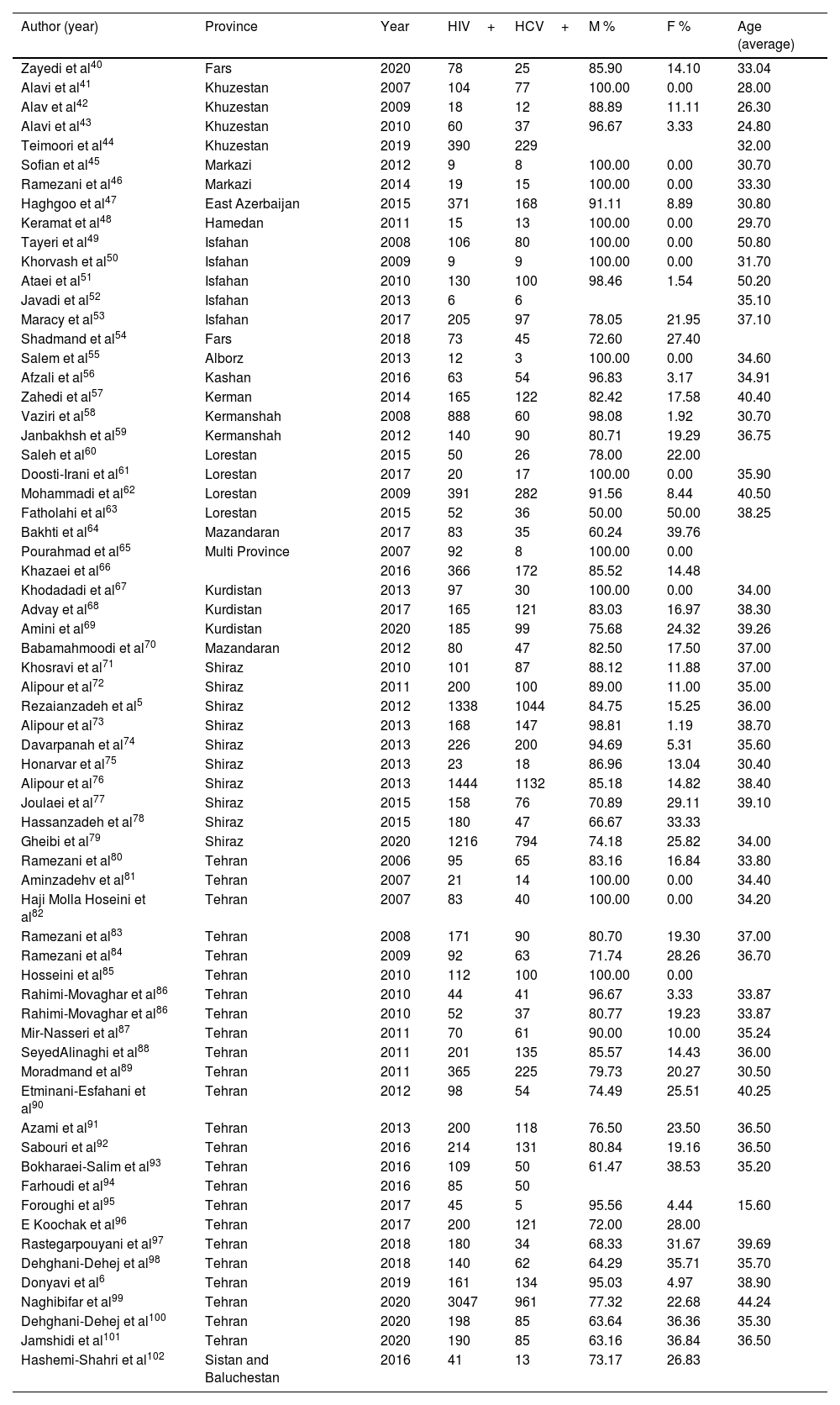Human immunodeficiency virus (HIV) and hepatitis C virus (HCV) infections are major public health issues worldwide. The present study aimed to estimate the prevalence of HCV among patients with HIV in Iran and evaluate the demographic and behavioral factors associated with a heterogeneity of results.
MethodsMEDLINE (via PubMed), Web of Science, SCOPUS, Google Scholar, Embase, and 2 Persian databases, including Scientific Information Database (SID) and Magiran, were used for a systematic search from January 1, 2005 to February 26, 2022. Data were analyzed according to country, publication time, enrolment time, number of patients, gender, mean age, HIV/HCV diagnosis method, and HIV/HCV treatment. The analysis was carried out using R and the metafor package.
ResultsWe found that 60.94 (95% CI 54.59–67.11) HIV-infected people in Iran were co-infected with HCV. The greatest burden of this co-infection was in the Hamedan 86.67 (62.12, 96.26), Kashan 85.71 (75.03, 92.30), followed by the Kerman 73.94(66.75, 80.04). The lowest prevalence of HBV-HCV co-infection was observed in Kermanshah at 11.91 (9.98, 13.98).
ConclusionHBV-HCV co-infection is a challenging and important medical condition because of its variable clinical manifestations, increased risk of cirrhosis and HCC, and unpredictable treatment response. Due to the heterogeneous distribution pattern of HBV–HCV infection in Iran, continuous prevention and control measurements and the implementation of further epidemiologic studies are necessary.
Las infecciones por el virus de la inmunodeficiencia humana (VIH) y el virus de la hepatitis C (VHC) son uno de los principales problemas de salud pública en el mundo. El objetivo del presente estudio fue El presente estudio tuvo como objetivo estimar la prevalencia de VHC entre pacientes con VIHVIH en Irán y evaluar los factores demográficos y de comportamiento asociados con una heterogeneidad de resultados.
Métodosse utilizaron MEDLINE (a través de PubMed), Web of Science, SCOPUS, Google Scholar, Embase y 2 bases de datos persas, incluida la base de datos de información científica (SIDSID) y Magiran, para una búsqueda sistemática desde el 1 de enero de 2005 hasta el 26 de febrero de 2022. Los datos se analizaron según el país, el tiempo de publicación, el tiempo de inscripción, el número de pacientes, el sexo, la edad media, el método de diagnóstico del VIH/VHC y el tratamiento del VIH/VHC. El análisis se realizó mediante R y el paquete metafor. El análisis estadístico se realizó mediante STATA versión 14 (StataCorp, College Station, Texas).
ResultadosEncontramos que 60,94 (IC del 95%: 54,59 a 67,11) personas infectadas por el VIH en Irán estaban coinfectadas con el VHC. La mayor carga de esta coinfección estuvo en Hamedan 86.67 (62.12, 96.26), Kashan 85.71 (75.03, 92.30), seguido por Kerman 73.94 (66.75, 80.04). La prevalencia más baja de coinfección VHB-VHC se observó en Kermanshah con 11,91 (9, 13, 98).
ConclusiónLa coinfección VHB-VHC es una condición médica desafiante e importante debido a sus manifestaciones clínicas variables, mayor riesgo de cirrosis y CHC, y respuesta impredecible al tratamiento. Debido al patrón heterogéneo de distribución de la infección por VHB-VHC en Irán, es necesario realizar medidas continuas de prevención y control y realizar más estudios epidemiológicos.
Artículo
Comprando el artículo el PDF del mismo podrá ser descargado
Precio 19,34 €
Comprar ahora










